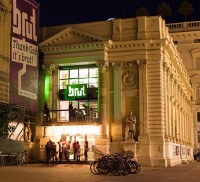
Although sound installations in Austria are rather sparse, the scene rather small, electronic music plays an important role in the 21st Century. And this both in the fields of experimental music as well as “traditional” electronic or electro-acoustic compositions.
Although it took quite some time before the first electronic studios were financed, at first in 1958 in Salzburg and later in Vienna, the interest in electronic and electro-acoustic music has not faded. Centers are located in Graz and Vienna, and the experimental electronic scene is still very much alive. There are quite a few composers of electronic and electro-acoustic music (just to name a few: Katharina Klement, Karlheinz Essl, Marco Ciciliani, Elisabeth Schimana, Daniel Lercher, Hui Ye, Michael Zacherl) that compose traditional electronic/electro-acoustic music (either pure, as a playback with instrumentalists or in the form of live electronics), but are also active as improvisers in various experimental music scenes. Alternating, as well as fluid boundaries included.
While in earlier days composers of electronic and electro-acoustic music were tied to large electronic studios to realize their work, this is not the case anymore. Of course there are exceptions, especially when extremely complex interconnections, sound editing or sound distribution processes have to be developed and require special studio equipment and/or technical knowledge. However, due to the countless possibilities of electronic composing, this does not necessarily apply to each composer. With the range of various programs, the domestic laptop has nowadays replaced a large electronic studio. It should also be noted that with the easy access of computing power, the aesthetic design possibilities have expanded. Particularly in the past fifteen to twenty years a lot of things have changed. Not only in the 
On the other hand, the maximum of computer performance and the uniformed matte silver laptops have also led to a “rollback” or rather a re-entry of things that were once pushed away. Trash-electronics, home-made electronics, converted everyday electronics or the targeted work with low-fi sound quality and recording equipment have been introduced to electronic composition and experimentation (eg. Tamara Wilhelm, Michael Zacherl or Angelica Castello).
As an escape from the sonic overkill, there are also a few refined tendencies of reduced microscopic concentration on individual sounds, sinus tones in the finest mixing and beat forms, such as with Tim Blechmann.
Education and Research


For many years, this course was led by Dieter Kaufmann. From 2002 to 2006 he was followed by the composer Germán Toro Pérez, who has been the head of the ICST – Institute for Computer Music projects and Sound Technology in Zurich since 2007. Katharina Klement then directed this course on an interim basis for several years, and now since 2010 Johannes Kretz is the head of the ELAK, together with a team including Katharina Klement, Marco Ciciliani and Wolfgang Musil. Wolfgang Musil is by the way one of the most influential sound directors of the live-electro-acoustic music scene in Austria, together with Alfred Reiter, Christina Bauer and of course the Klangforum sound directors Florian Bogner and Peter Böhm, and Christoph Amann (even though he primarily produces excellent live recordings and studio recordings).
Today’s most acclaimed names in the field of electronics and electro-acoustics of various forms from Austria include numerous ELAK graduates. The importance of this training course and its influence on many composers is emphasized, for example, by Katharina Klement in a mica-interview.

Also coupled with the Institute for Composition and Electro-acoustics at the University of Vienna, is the Center for Innovative Music Technology (ZiMT), founded in 2008 and again directed by Johannes Kretz. The center focuses on research in the field of computer-assisted music theory, as well as computer music and multimedia performance.
Listening to Electronic Music – Venues

Back to the Future or: IMA – Institute for Media Archeology

Composers
To name all Austrian composers that have seriously and intensively dedicated themselves to electronic and electro-acoustic music would result – fortunately! – in a long, long list and would represent composers of the older generation, the middle to younger generation. Composers that were devoted to purely electronic music, as well as those preferably using electronics as a playback, integrated in instrumental compositions or performances. Composers that focused on live-electronics as performance art in conceptual and free improvised music, or those who have made a name for themselves as sound or studio directors. Transgressions included. Likewise, it would be confusing to list all of the different aesthetic approaches of the artists in a concise manner. A more or less unified movement or an “Austrian School” of electronic or electro-acoustic nature can not be singled out, a phenomenon that takes account to the fact of the universal availability of aesthetical and production knowledge, but also the technical possibilities in times of seemingly limitless, Internet-based media influences, on the other hand also the various teaching and mediative approaches of electronic music in Austria – whether in universities, courses, or self-taught.
Productive aesthetic diversity – a small list: Focus on sound – sound layering, development and use of interactive systems, transfers of scientific ideas on electronic sound structures, algorithmic composition, taking into account auto poetic systems, various systems of live interaction and live transformation, work with field recordings, sound analysis and synthesis techniques, embedded in numerous old and new sound processing methods are implemented and, depending on the composer, lead to various different aesthetic sonic results.
Nina Polaschegg
(translated from German)
Photos:
Gerhard E. Winkler
IEM Cube
ZiMT
Brut Wien
IMA – Institute of Media Archaeology
